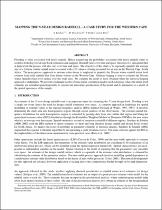JavaScript is disabled for your browser. Some features of this site may not work without it.
- ResearchSpace
- →
- Research Publications/Outputs
- →
- Conference Publications
- →
- View Item
| dc.contributor.author |
Khuluse, S

|
|
| dc.contributor.author |
Dowdeswell, M

|
|
| dc.contributor.author |
Debba, Pravesh

|
|
| dc.contributor.author |
Stein, A

|
|
| dc.date.accessioned | 2011-02-11T12:11:35Z | |
| dc.date.available | 2011-02-11T12:11:35Z | |
| dc.date.issued | 2010-11 | |
| dc.identifier.citation | Khuluse, S, Dowdeswell, M, Debba, P, et al. 2010. Mapping the N-year design rainfall - A case study for the Western Cape. SASA peer-reviewed Proceedings. North-West University, Potchefstroom Campus, 10-12 November 2010, pp 10 | en_US |
| dc.identifier.isbn | 9780620487085 | |
| dc.identifier.uri | http://hdl.handle.net/10204/4842 | |
| dc.description | SASA peer-reviewed Proceedings.North-West University, Potchefstroom Campus, 10-12 November 2010 | en_US |
| dc.description.abstract | Flooding is often associated with heavy rainfall. Hence quantifying the probability associated with heavy rainfall events is useful in hydrology for design flood estimation and mapping Rainfall varies over time and space, therefore it is anticipated that at high levels the process will also vary over time and space. The objective of this study is to regionally quantify the average size of a 24-hour winter rainfall event associated with a 2% chance of being exceeded for an area in the Western Cape, South Africa. The point process approach to extreme value theory is employed to quantify the 50-year winter rainfall return level estimate from daily rainfall data from fifteen stations in the Western Cape. Ordinary kriging is used to estimate the 50-year winter rainfall return level surface over the study area. We compare the result to those obtained when the universal kriging approach is undertaken. We present a technique used to obtain spatial correlation models used in kriging, where the return level estimates are extended spatiotemporally, to circumvent inaccurate specification of the model and its parameters as a result of the spatial sparseness of the sample. | en_US |
| dc.language.iso | en | en_US |
| dc.relation.ispartofseries | Workflow request;5755 | |
| dc.subject | Rainfall | en_US |
| dc.subject | N-year design rainfall | en_US |
| dc.subject | Flooding | en_US |
| dc.subject | Geostatistics | en_US |
| dc.subject | External drift kriging | en_US |
| dc.title | Mapping the N-Year design rainfall - A case study for the Western Cape | en_US |
| dc.type | Conference Presentation | en_US |
| dc.identifier.apacitation | Khuluse, S., Dowdeswell, M., Debba, P., & Stein, A. (2010). Mapping the N-Year design rainfall - A case study for the Western Cape. http://hdl.handle.net/10204/4842 | en_ZA |
| dc.identifier.chicagocitation | Khuluse, S, M Dowdeswell, Pravesh Debba, and A Stein. "Mapping the N-Year design rainfall - A case study for the Western Cape." (2010): http://hdl.handle.net/10204/4842 | en_ZA |
| dc.identifier.vancouvercitation | Khuluse S, Dowdeswell M, Debba P, Stein A, Mapping the N-Year design rainfall - A case study for the Western Cape; 2010. http://hdl.handle.net/10204/4842 . | en_ZA |
| dc.identifier.ris | TY - Conference Presentation AU - Khuluse, S AU - Dowdeswell, M AU - Debba, Pravesh AU - Stein, A AB - Flooding is often associated with heavy rainfall. Hence quantifying the probability associated with heavy rainfall events is useful in hydrology for design flood estimation and mapping Rainfall varies over time and space, therefore it is anticipated that at high levels the process will also vary over time and space. The objective of this study is to regionally quantify the average size of a 24-hour winter rainfall event associated with a 2% chance of being exceeded for an area in the Western Cape, South Africa. The point process approach to extreme value theory is employed to quantify the 50-year winter rainfall return level estimate from daily rainfall data from fifteen stations in the Western Cape. Ordinary kriging is used to estimate the 50-year winter rainfall return level surface over the study area. We compare the result to those obtained when the universal kriging approach is undertaken. We present a technique used to obtain spatial correlation models used in kriging, where the return level estimates are extended spatiotemporally, to circumvent inaccurate specification of the model and its parameters as a result of the spatial sparseness of the sample. DA - 2010-11 DB - ResearchSpace DP - CSIR KW - Rainfall KW - N-year design rainfall KW - Flooding KW - Geostatistics KW - External drift kriging LK - https://researchspace.csir.co.za PY - 2010 SM - 9780620487085 T1 - Mapping the N-Year design rainfall - A case study for the Western Cape TI - Mapping the N-Year design rainfall - A case study for the Western Cape UR - http://hdl.handle.net/10204/4842 ER - | en_ZA |






